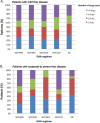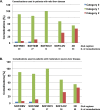Real-life data on potential drug-drug interactions in patients with chronic hepatitis C viral infection undergoing antiviral therapy with interferon-free DAAs in the PITER Cohort Study
- PMID: 28245248
- PMCID: PMC5330484
- DOI: 10.1371/journal.pone.0172159
Real-life data on potential drug-drug interactions in patients with chronic hepatitis C viral infection undergoing antiviral therapy with interferon-free DAAs in the PITER Cohort Study
Erratum in
-
Correction: Real-life data on potential drug-drug interactions in patients with chronic hepatitis C viral infection undergoing antiviral therapy with interferon-free DAAs in the PITER Cohort Study.PLoS One. 2018 Jan 2;13(1):e0190803. doi: 10.1371/journal.pone.0190803. eCollection 2018. PLoS One. 2018. PMID: 29293676 Free PMC article.
Abstract
Background: There are few real-life data on the potential drug-drug interactions (DDIs) between anti-HCV direct-acting antivirals (DAAs) and the comedications used.
Aim: To assess the potential DDIs of DAAs in HCV-infected outpatients, according to the severity of liver disease and comedication used in a prospective multicentric study.
Methods: Data from patients in 15 clinical centers who had started a DAA regimen and were receiving comedications during March 2015 to March 2016 were prospectively evaluated. The DDIs for each regimen and comedication were assigned according to HepC Drug Interactions (www.hep-druginteractions.org).
Results: Of the 449 patients evaluated, 86 had mild liver disease and 363 had moderate-to-severe disease. The use of a single comedication was more frequent among patients with mild liver disease (p = 0.03), whereas utilization of more than three drugs among those with moderate-to-severe disease (p = 0.05). Of the 142 comedications used in 86 patients with mild disease, 27 (20%) may require dose adjustment/closer monitoring, none was contraindicated. Of the 322 comedications used in 363 patients with moderate-to-severe liver disease, 82 (25%) were classified with potential DDIs that required only monitoring and dose adjustments; 10 (3%) were contraindicated in severe liver disease. In patients with mild liver disease 30% (26/86) used at least one drug with a potential DDI whereas of the 363 patients with moderate-to-severe liver disease, 161 (44%) were at risk for one or more DDI.
Conclusions: Based on these results, we can estimate that 30-44% of patients undergoing DAA and taking comedications are at risk of a clinically significant DDI. This data indicates the need for increased awareness of potential DDI during DAA therapy, especially in patients with moderate-to-severe liver disease. For several drugs, the recommendation related to the DDI changes from "dose adjustment/closer monitoring", in mild to moderate liver disease, to "the use is contraindicated" in severe liver disease.
Conflict of interest statement
Figures


References
-
- Patel N, Nasiri M, Koroglu A, Bliss S, Davis M, McNutt LA, Miller C. A cross-sectional study comparing the frequency of drug interactions after adding simeprevir-or sofosbuvir-containing therapy to medication profiles of hepatitis C monoinfected patients. Infect Dis Ther 2015; 4: 67–78. - PMC - PubMed
-
- Polepally AR, King JR, Ding B, Shuster DL, Dumas EO, Khatri A, et al. Drug-drug interactions between the anti-hepatitis C virus 3D regimen of ombitasvir, paritaprevir/ritonavir, and dasabuvir and eight commonly used medications in healthy volunteers. Clin Pharmacokinet 2016; 55: 1003–1014. 10.1007/s40262-016-0373-8 - DOI - PMC - PubMed
Publication types
MeSH terms
Substances
LinkOut - more resources
Full Text Sources
Other Literature Sources
Medical

